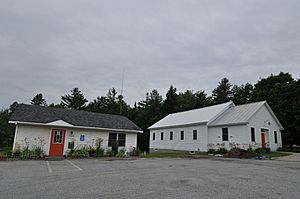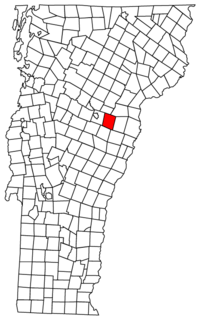Orange, Vermont facts for kids
Quick facts for kids
Orange, Vermont
|
|
|---|---|
 |
|

Orange, Vermont
|
|
| Country | United States |
| State | Vermont |
| County | Orange |
| Communities | Orange East Orange |
| Area | |
| • Total | 39.0 sq mi (101.0 km2) |
| • Land | 38.8 sq mi (100.4 km2) |
| • Water | 0.2 sq mi (0.6 km2) |
| Elevation | 1,923 ft (586 m) |
| Population
(2020)
|
|
| • Total | 1,048 |
| • Density | 27/sq mi (10.4/km2) |
| Time zone | UTC-5 (Eastern (EST)) |
| • Summer (DST) | UTC-4 (EDT) |
| ZIP Codes | |
| Area code(s) | 802 |
| FIPS code | 50-53425 |
| GNIS feature ID | 1462167 |
Orange is a town located in Orange County, Vermont, United States. In 2020, the town had a population of 1,048 people.
Contents
Geography of Orange
Orange is a town in Vermont with a total area of about 39 square miles (101 square kilometers). Most of this area, 38.8 square miles (100.4 square kilometers), is land. A small part, 0.2 square miles (0.6 square kilometers), is water.
The Waits River flows through the northeastern part of Orange. The town is also home to the Dix Reservoir. This reservoir is a very important water source for the nearby town of Barre. It also has facilities to treat the water.
Population and People
Over the years, the population of Orange has changed. In 1800, there were 348 people living here. The population grew to over 1,000 people by 1830. After that, it slowly decreased for many years.
By 1950, only 410 people lived in Orange. However, the population started to grow again in the second half of the 1900s. In 2010, there were 1,072 residents. The most recent count in 2020 showed 1,048 people living in Orange.
Most people in Orange are White. A small number of residents are from other racial backgrounds. About 1.55% of the population is Hispanic or Latino.
In 2000, there were 362 households in Orange. Many of these households (37.3%) had children under 18 living with them. The average household had about 2.67 people. The average family had about 3.03 people.
The median age in Orange in 2000 was 38 years old. This means half the people were younger than 38 and half were older. About 27% of the population was under 18 years old. Another 10.6% were 65 years or older.
History of Orange
The town of Orange was first granted in 1780. This happened during the American Revolution. The government of Vermont gave the land to Captain Ebenezer Green, Amos Robinson, and 63 other people. At that time, different states were arguing over who controlled Vermont. Vermont eventually won this right.
The first people to settle in Orange arrived in 1793. Joseph Williams and his family built a house in the southern part of the town. Orange officially became a town in 1796. The first town meeting took place at Joseph Williams's home.
At this meeting, the first town government was chosen. Joseph Thayer became the town meeting moderator. John Sloane was the town clerk. Thomas Storrs Paine, Fairbanks Bush, and Gould Camp were chosen as selectmen. Gould Camp also became the town treasurer.
In 1798, Orange was represented in the Vermont House of Representatives for the first time. Ezra Goodale was elected to represent the town.
Notable People from Orange
Many interesting people have come from Orange, Vermont:
- Edna Beard: She was the first woman to serve in the Vermont House of Representatives (from 1921 to 1923). She was also the first woman to serve in the Vermont Senate (from 1923 to 1925).
- Benjamin F. Fifield: A lawyer who worked for the United States government. He was the United States Attorney for Vermont from 1869 to 1880.
- Alexander Kennedy Miller: He was an aviator, which means he flew airplanes. He was also known for collecting old and rare cars.
- Frank P. Sargent: A leader for railroad workers' unions. He later became the U.S. Commissioner General of Immigration.
- Stanley C. Wilson: He served as the Governor of Vermont from 1931 to 1935.
See also
 In Spanish: Orange (Vermont) para niños
In Spanish: Orange (Vermont) para niños


